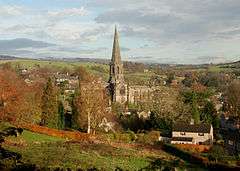All Saints Church, Bakewell
| All Saints Church | |
|---|---|
 | |
| 53°12′46″N 1°40′43″W / 53.2129°N 1.6786°WCoordinates: 53°12′46″N 1°40′43″W / 53.2129°N 1.6786°W | |
| Location | Bakewell, Derbyshire |
| Country | England |
| Denomination | Church of England |
| Administration | |
| Diocese | Diocese of Derby |
All Saints Church, Bakewell, is the parish church of Bakewell, Derbyshire. It is a Grade I listed building.
The first church
The church was founded in 920, during Anglo-Saxon times and the churchyard has two 9th-century crosses. During restoration work, in the 1840s, many carved fragments of Anglo-Saxon stonework were found in and around the porch, as well as some ancient stone coffins.
The present church
The present church was started in the 12th century in Norman style; however, only the west front and part of the nave survive from that time. The remainder of the church was built between 1220 and 1240. The spire was added in 1340 but, in 1840, was completely rebuilt as it had become dangerous. as part of the restoration by William Flockton.[1]
Misericords
All Saints' contains three early-15th-century misericords, along with eighteen 19th-century misericords in the choir stalls. Additionally, there is one 19th-century misericord on a priest's seat. The 19th-century misericords date from 1881.
Relics and monuments

The church has some interesting relics of the Vernon and Manners families as well as a fine 14th-century baptismal font. In the Vernon Chapel (off the South aisle) there are several magnificent tombs: Sir Thomas Wendesley (killed at the Battle of Shrewsbury in 1403; John Vernon of Haddon Hall, who died in 1477; and Sir George Vernon and his two wives.[2]
Sir George, nicknamed 'King of the Peak',[3] died in 1567, is famous as the father of Dorothy Vernon, who eloped with Sir John Manners, both of whom have a monument at the South end of the chapel. There is also a monument to their son, George Manners and his wife Grace.
Outside the chapel is a much smaller 14th-century alabaster monument to Sir Godfrey de Foljambe and his wife.[2] The monument is said to be very rare, with only two of that age surviving to the present day. It shows Foljambe and his wife as if they are looking out of a window and this can still be seen on the south wall.[4] Below the mural is an explanatory inscription, but this dates from only 1803 and was "added by Mr Blore".[2]
Organ
The organ dates from 1810 when a "finger organ"[5] by J Lincoln was installed. This was rebuilt in 1851 by William Hill, and again in 1883 by Brindley & Foster.[6] Further work by Jardine and Co in 1954 and George Sixsmith in 1989 have left the church with a 3 manual 42 speaking stop pipe organ. A specification of the organ can be found on the British Institute of Organ Studies National Pipe Organ Register at N00212.
Organists
- C.C. Mitchell 1873[7] - 1877
- Thomas Barker Mellor 1877 – 1913
- G.C.E. Eyres 1913[8] - ???? (formerly organist of Walsall Parish Church)
- W.E. Cave 1913[9] – 1932 (afterwards organist of Whitby Parish Church)
- T.H. Mosley 1932[10] - ???? (previously organist of St Peter's Church, Edensor, Derbyshire)
- Glyn Davies 1982 – ????
The church today
Today, along with its regular religious services, the church is an important building in the town and the wider Peak District. It is used for, amongst other things, concerts by Bakewell Choral Society and the annual Commemoration service of Lady Manners School when they staff and pupils give thanks to Grace, Lady Manners, for founding their school in 1636.
The church website has much more information about the ongoing life and worship of the parish, including forthcoming services and other events.
See also
Gallery
-

9th-century cross in the churchyard
References
- ↑ English Heritage (1951) Church of All Saints. Images of England (Retrieved 22 January 2006—free registration required).
- 1 2 3 'Parishes: Bakewell', Magna Britannia: volume 5: Derbyshire (1817), pp. 23–43. URL: http://www.british-history.ac.uk/report.aspx?compid=50721 Date accessed: 30 August 2013
- ↑ King of the Peak
- ↑ Gardner, Arthur (2011). Alabaster Tombs of the Pre-Reformation Period in England. Cambridge University Press. p. 13. ISBN 0521166209.
- ↑ Barrel organ: the story of the mechanical organ and its repair. Arthur W. J. G. Ord-Hume. 1978
- ↑ "Opening of a new organ at Bakewell Church". Derbyshire Times and Chesterfield Herald. Chesterfield. 12 May 1883. Retrieved 23 April 2015.
- ↑ "Election of Organist". Derbyshire Times and Chesterfield Herald. Chesterfield. 1 February 1873. Retrieved 23 April 2015.
- ↑ "New Organist at Bakewell Church". Derby Daily Telegraph. Derby. 4 October 1913. Retrieved 23 April 2015.
- ↑ Frederick W Thornsby. Dictionary of organs and organists. 1913
- ↑ "Organist at Bakewell". Derbyshire Times and Chesterfield Herald. Chesterfield. 10 September 1932. Retrieved 23 April 2015.